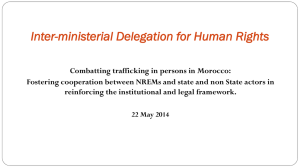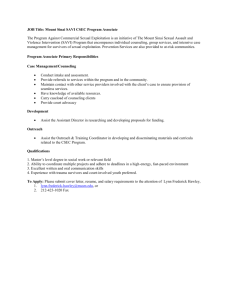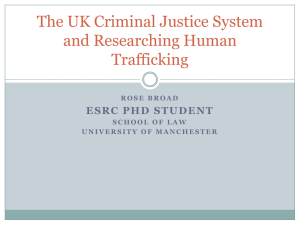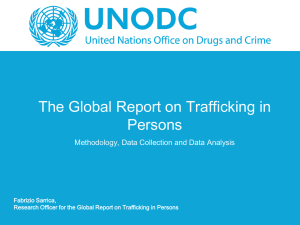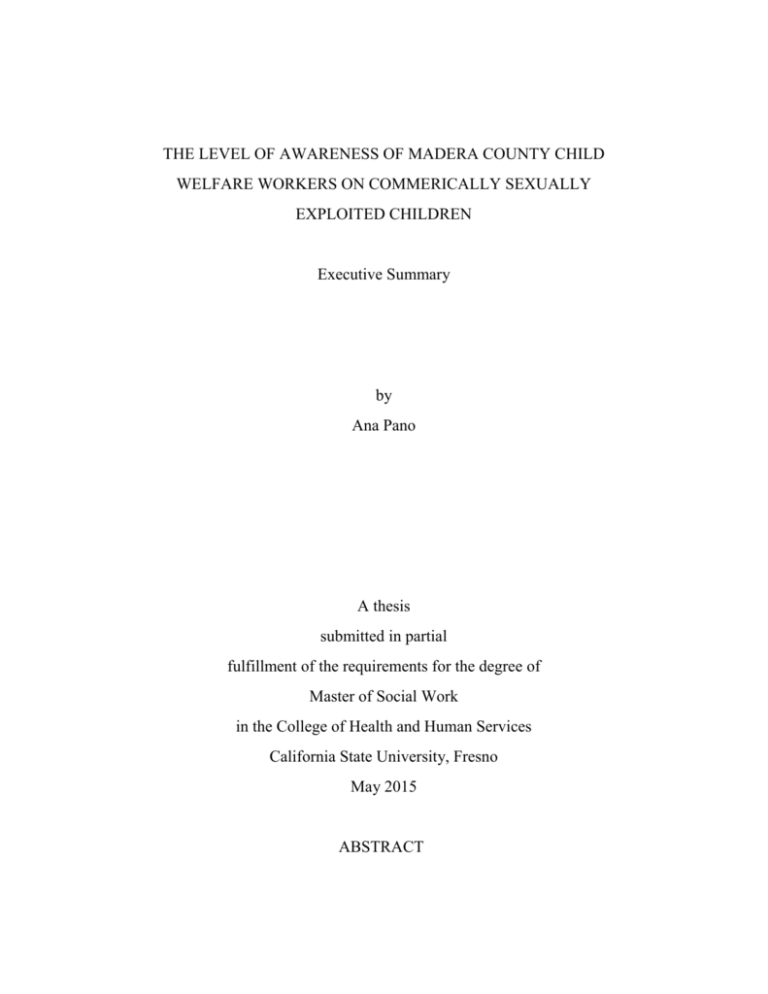
THE LEVEL OF AWARENESS OF MADERA COUNTY CHILD
WELFARE WORKERS ON COMMERICALLY SEXUALLY
EXPLOITED CHILDREN
Executive Summary
by
Ana Pano
A thesis
submitted in partial
fulfillment of the requirements for the degree of
Master of Social Work
in the College of Health and Human Services
California State University, Fresno
May 2015
ABSTRACT
THE LEVEL OF AWARENESS OF MADERA COUNTY CHILD
WELFARE WORKERS ON COMMERICALLY SEXUALLY
EXPLOITED CHILDREN
The commercial sexual exploitation of children (CSEC) is a domestic
problem that is estimated to affect 100,000 United States children each year
(Walker, 2013). The Office of Juvenile Justice and Delinquency Prevention
(2013) states the commercial sexual exploitation of children involves sexual
crimes committed against children and juvenile victims for financial or other
economic reasons. Commercially sexually exploited children often include
children who are neglected or abused, in foster care, runaways, substance abusers,
and homeless. Due to the hidden nature of this crime, data regarding sexual
exploitation is extremely limited. Furthermore, limited data from child welfare
agencies suggest that social workers may lack training and knowledge regarding
this matter. In this quantitative, descriptive study, a questionnaire was distributed
to 26 Madera County Child Welfare social workers to assess their knowledge and
awareness about CSEC. Findings suggest that Madera County Child Welfare
social workers have an overall understanding and awareness of CSEC. However
most participants reported that they were unsure as to whether they asked specific
questions during interviews to identify suspected victims of sex trafficking. The
majority of respondents also reported a lack of knowledge about whether their
agency has a relationship with local police and youth shelters in order to help
CSEC victims.
Ana Pano
May 2015
1
INTRODUCTION
The human trafficking trade is a modern form of slavery. The terminology
“human trafficking” is an umbrella term for various kinds of exploitation of persons,
including sex trafficking, labor trafficking, child soldiery, bonded labor, and organ
trafficking (RestoreCorps, n.d.). It is a brutal and criminal industry that hides and
exploits millions of individuals, mostly women and children, who are victimized in the
dark throughout the world. This form of exploitation intersects different areas such as
socio-economic status, educational-level, abuse, violence, and gender. In the United
States, recent sting operations by the FBI brought media attention to hundreds of
thousands of children under the age of 18 who are forced into prostitution, pornography,
stripping, escorting, and sex tourism. The commercial sexual exploitation of children
(CSEC) is extortion perpetuated towards children through the use of violence and
coercion.
Victims of human trafficking are virtually invisible to mainstream culture and
identifying and assisting victims is one of the greatest challenges (Garrity & McClain,
2011). The United States is one of the top 10 destinations for human trafficking with
reports of trafficking in over 90 cities (Hepburn & Simon, 2010). Although human
trafficking is receiving increased attention in the United States, estimates and details
about human trafficking remain elusive; even globally, the estimates of bodies used as
slaves are still unknown (Hunt, Logan, & Walker, 2009). Inaccurate estimates and
limited research have only provided a scope of what is considered to be the total
worldwide. Currently, there are 20.9 million victims of human trafficking globally
(National Human Trafficking Resource Center, 2014). An estimate annual worldwide
2
profit of $44.3 billion is made from persons trafficked globally (Hepburn & Simon,
2010).
LITERATURE REVIEW
Conceptual Framework
Globalization, Feminist Theory, and Trauma Bonding Theory were used in this
study to help understand human trafficking/CSEC still exists throughout the world.
Globalization has created a world with an integrated global economy marked by free
trade, free flow of capital, and the tapping of cheaper foreign labor markets
(Globalization, 2014). Many countries that have economically lower levels per capita
have increasingly higher risk for exploitation of people. Some of these countries include:
Asia, South America, South East Asia, Central America, and North America. Issues
related to victims include: poverty, unemployment, low social status, lack of
opportunities, few prospects for the future, an idealistic view of the Western world and
wealthier countries powers globalization (Amir & Beeks, 2009). For internationally
trafficked adolescents, the promise of a better life in another country is frequently enough
for girls or for their families to give them over to traffickers (Hodge & Lietz, 2007).
Victims are presented with marriages, modeling, jobs, and fake promises in foreign
countries only to be forced into trafficking.
Feminist Theory is concerned with understanding fundamental inequalities
between women and men with analyses of male power over women. It’s the basic
premise that male dominance derives from the social, economic and political
arrangements to specific societies. Historically, women have been marginalized from
resources or power and have unequal power relationships with males in almost all
3
societies. The growth of a billion dollar entertainment and sex industry has been based on
male-centered ideology (Best Practice, 2003).
Traumatic bonding theory suggest that the relationship “develops between two
persons where one person intermittently harass, beats, threatens, abuses, or intimates the
other” (Petocsky & Swanger, 2003, p. 37). This relationship has also been referred to as
Stockholm Syndrome in which “both child and adult victims of human trafficking may
experience traumatic bonding, experiencing terror toward their captors, but also gratitude
for supposed favors.
Risk Factors
This study identified several risk factors that make children and youth vulnerable
to trafficking: substance abuse, homelessness, sexual and emotional abuse. Drugs and
alcohol abuse are considered motivators into entry and continuation of prostitution.
Brawn and Roe-Sepowitz (2008) found in their study of young girls that indicated
approximately 60% of their juvenile sample used alcohol and drugs. They also found
substance-abusing females were more likely to be white, living in unstable situations and
in disorganized families. Heilemann and Santhiveern (2011) also found in their female
adolescents sample, that they used illegal substances and alcohol to cope with emotions
related to prostitution.
Several studies have shown that children and youth who have been homeless are
at a greater risk for sexual exploitation. Many of the respondents stated that they needed
basic survival commodities to survive. According to Johnson and Tyler (2006) the most
common reason for running away was stress or becoming overwhelmed with family
problems. Another study also reported that homeless youth engaged in prostitution to
4
provide for their basic needs (Prior & Williamson, 2009). Chong et al. (2011) found a
correlation to sexual exploitation of children and emotional and sexual abuse. Chong
found that at least one situation in which family dysfunction occurred and psychological
maltreatment in prostituted youth and children. According to Dominique and RoeSepowtiz (2012), experiences of early childhood are considered primary risk factors for
commercial sexual exploitation of children.
Human Services
Child protection agencies and law enforcement are typically responsible for outreach,
identification, and services in human trafficking cases. The United States Department in
2009 conducted a study that found that found human health and law enforcement officials
had difficulty identifying victims. The Wisconsin Office of Justice Assistance (2008)
also found there was uncertainty among service providers of the qualifications for an
individual to be protected under the trafficking Victims Protection Act of 2000. It was
also found that the majority of justice system agencies did not have a plan or services for
human trafficking victims.
In 2013, the United States Department of Health and Human Services (DHHS)
recognized there is a limited amount of aggregate data to identify the prevalence and
characteristics of victims within the child welfare, runaway, and homeless youth systems
(Administration for Children, Youth and Families, 2013). DHHS furthered stated while
there are some emerging practices within child welfare systems, runaway and homeless
youth programs, there is still work to be done to create evidence-based interventions and
mediations that advocate improved outcomes specifically for CSEC victims.
The criminal system continues to charge United States children as prostitution
5
offenders instead of treating them as sexually exploited youth. These children typically
suffer from poverty, trauma, sexual abuse, and are especially vulnerable to pimps and
traffickers (Mir, 2013). Most often, minor girls who are picked up for prostitution offense
are seen as self-prostituting, rather than as victims. Usually these victims have personal
and family histories of substance abuse and physical or sexual violence (Mir, 2013).
According to the analysis of the National Incident-Based Reporting System, police tend
to view youth involved in prostitution as offenders (Halter, 2010). The sexual
exploitation of children is a social issue that continues to have challenges due to its lack
of clarity and complexity.
The child welfare system lacks data on trainings and the vital role social workers
hold in mediation with sexually exploited children. Agencies use their own databases and
this may lead to gaps in identification and such challenges as variations in definition of
terms (such as CSEC and trafficking) that leads to difficulty in identify victims
(Greenbaum, 2014). Child welfare agencies are left with gathering and researching their
own protocols on identifying victims. In Florida, the Department of Children and
Families released a human trafficking children tool indicator to assist child welfare
workers in understanding human trafficking and identifying children who are victims
themselves. However, the information provided with the tool indicates that it does not
measure all instances of human trafficking or areas that may be explored to determine if
human trafficking is present.
The lack of research on identifying children as victims during the screening
process may reduce the likelihood that child welfare social workers will ask questions
related to sexual exploitation. According to Greenbaum, “adults and children subjected to
6
trafficking do not self-identify, often due to shame, fear, and guilt” (p. 247). The fact
victims themselves do not identify and child welfare workers do not ask proper questions
may place victims at greater risk. Overall, there is a gap in current literature regarding
the level of awareness among social workers in child welfare services. There is currently
little research regarding knowledge and awareness about the sexual exploitation of
children among social workers in the child welfare system. Research is needed to
examine whether social workers are equipped to understand and intervene with CSEC
victims.
Methodology
The purpose of this quantitative descriptive study is to examine child welfare
social workers’ awareness and ability to identify and assess victims of commercially
sexually exploited children. A cross-sectional survey design was used for this study with
descriptive quantitative research methods. The survey assessed the level of awareness
about CSEC children among child welfare social workers and barriers that prevent the
identification of these children in the child welfare system. The following research
questions are addressed in this study:
1. What is the current level of awareness of social workers in CSEC?
2. What are the barriers to the identification of CSEC victims?
A total of 26 social workers, from Madera County child welfare services were
involved in this study. The researcher provided a copy of the cover letter for this study to
director, deputy director, and child welfare workers. The deputy director sent an email to
child welfare workers one week prior to the agency’s monthly division meeting. The
email was sent to all child welfare social workers interested in participating in this survey
7
during the last 25 minutes of the division meeting. Surveys were handed out at the end of
the meeting. Once completed, social workers inserted anonymous surveys in a folder
located at the entrance of the door.
The survey included questions derived from two pre-existing instruments
developed by the Minnesota Advocates for Human Rights and Shared Hope International.
The survey questions include information about the participant’s gender, age group, and
experience in child welfare. The survey questions also include information about the
subject’s level of awareness about CSEC, identification of victims, and possible barriers
faced when interviewing a possible victim. The survey contained 21 close-ended
questions and four follow-up written questions. It contained seven true and false
questions.
FINDINGS
The following section presents the main findings gathered from surveys of 26
Madera County child welfare social workers.
Demographics
The participants in the study were 26 Madera County child welfare social workers
from Madera, California; 92% were female and 8% were male. In terms of age, 42.3%
were 21-35 years old, 42.3% were 35-50 years old, and 15.4% were 51-65 years old. The
majority of participants (73.1%), held master’s degrees, 19.2% had bachelor’s degrees,
and 7.7% held “other” degrees. Lastly, (46.2%) of participants had worked between 2
and 5 years in child welfare, 19.2% of the participants had worked 6-10, years, 30.8%
had worked 11-15 years, and 3.8% had worked for 16-20 years in child welfare.
8
General Understanding
After demographic data was collected from participates, they were asked to selfrate their general understanding of commercially sexually exploited children; 11.5% of
the participants rated their understanding as excellent, 38.5 % as good, 30.8% as average,
7.7% as fair, and 11.5% as poor.
Characteristics of a Recruiter/Trafficker/Pimp
Respondents were also asked to describe the “typical” characteristics of a
recruiter/trafficker/pimp. A total of 15 participants provided written responses. Seven
participants reported similar written responses about personalities and physical
appearances typically seen in pimps/traffickers. One respondent stated, “pimps are good
looking and manipulative.” Another respondent wrote, that “pimps are very charming
and charismatic. They tend to have a great deal of influence over others, very personable,
and caring at first.” Another participant stated, “pimps/traffickers gain trust and then ask
for favors, usually have “help” roles towards children and have the skills to gain trust and
influence over others.”
Knowledge about CSEC
Respondents were also asked to rate their understanding of the precise meaning of
term human trafficking (see Table 1). The majority of the Madera County social workers
rated themselves; 53.8% as “good” and 15.4% rated as “excellent.”
9
Table 1
Respondents Self-ratings of Understanding of Term Human Trafficking
Understanding of Human trafficking
Frequency
Percentage
Excellent
4
15.4
Good
14
53.8
Average
7
26.9
Fair
1
9.8
Poor
0
0.0
Participants were also asked to rate their knowledge about the recruitment process
typically used by traffickers or pimps with children; 11.5% rated their knowledge as
“excellent,” 34.8% rated themselves as “good,” 30.8% rated themselves as “average,”
19.2% reported “fair,” and 3.8% self-rated as “poor” (see Table 2).
Table 2
Respondents Self-Ratings of their Knowledge of Recruitment Process Used by
Traffickers/Pimps with Children
Rated Knowledge on the Recruitment Process
Frequency
Percentage
Excellent
3
11.5
Good
9
34.8
Average
8
30.8
Fair
5
19.2
Poor
1
3.8
Table 3 highlights responses to a seven true/false questionnaire designed to
examine respondents’ knowledge of situations and scenarios related to CSEC and social
work practice. The correct response for each of the true/false questions was “true.”
10
Table 3
Seven Questionnaire on Knowledge about CSEC
Knowledge about CSEC
1.Trafficked youth and children often self-disclose exploitation to
social workers or human health professionals
True
False
2. Children who are trafficked may still be under the control of a
pimp/trafficker, even after they are returned to foster care,
family home, or are rescued
True
False
3. Outward symptoms of depression or hostility may present as
difficult behavior to assistance when working with a possible
victim.
True
False
4. Sexually exploited children and youth often identify as victims
True
False
5. Prior sexual abuse is commonly experienced among
commercially sexually exploited children
True
False
6. Exploited children typically report their traffickers/pimps
True
False
7. Chronic runaway and homeless youth are at highest risk for
exploitation
True
False
Frequency
Percentage
4
22
15.4
84.6
25
0
100.0
0.0
26
0
100.0
0.0
12
14
46.2
53.8
21
4
84.0
14.8
7
19
26.9
73.1
25
1
92.6
3.8
One hundred percent of the respondents correctly identified “true” when asked if
children who are trafficked may still be under the control of a pimp/trafficker, even after
they are returned to foster care, a family home, or rescued. All 100% of respondents
answered “true” when asked whether symptoms of depression or hostility may present as
difficult behavior toward assistance when working with a possible victim. The majority
of respondents 92.2% correctly answered “true” when asked whether chronic runaway
and homeless youth are at highest risk for exploitation; 84% of the respondents also
answered “true” correctly to the question about whether sexual abuse a common
11
experience among victims. Less than half of respondents, 46.2%, answered “true” when
asked whether sexual exploited children often identify as victims. At 15.4 %, participants
answered “true” to the question about whether children and youth self-disclose to social
workers or human health professionals about their victimization.
The total number of true responses for each respondent was summated to assess
the respondents’ overall knowledge about CSEC. The mean score on the scale was 4.7
(SD=.9999); 4.2% of respondents received a perfect score of 7; 16.7% received 6 correct
responses; 33.3% had 5 correct responses; 37.5% had 4 correct responses, and 8.3% had
3 correct answers.
Participants were asked about the extent to which they would agree or disagree
that they experienced difficulty in interviewing a possible victim of CSEC. Table 4
illustrates the participants’ responses; 30.8% of the respondents agreed, 26.9% were not
sure/neutral, 34.6% disagreed, and 7.7% strongly disagreed that it was difficult to
interview a possible victim of CSEC.
Table 4
Difficulty in Interviewing a Possible Victim of CSEC
Difficulty in Interviewing
Frequency
Percentage
Strongly agree
0
0
Agree
8
30.8
Not sure/Neutral
7
26.9
Disagree
9
34.6
Strongly disagree
2
7.7
12
Participants that perceived difficulty in interviewing victims were asked to
provide written follow-up responses. A total of 11 participants provided follow-up
answers to this question. Four respondents similarly described difficulty with
engagement and interview process with possible victims. One participant reported
difficulty in terms of “asking the right questions when interviewing a child without
making them scared.” Another respondent reported that “knowing how to engage during
the interview process” was difficult. Another respondent stated, “The victims might live
in the same community and are scared to come forward and speak against the
perpetrator.” Two respondents described the need to provide a safe environment for
interview and disclosure.
Response Barriers to CSEC
Participants were also asked to self-rate perceived barriers in responding to a
possible victim of commercial exploitation; 60.9% of respondents felt that there were
barriers and 39.1% did not. The following question asked participants to provide written
responses to perceived barriers while responding to a possible victim of CSEC. Fourteen
respondents provided written responses to the follow-up question. One respondent stated
that barriers included “locating a victim, fear of victim, lack of training by [the] social
worker, and lack of collaboration with other agencies” as possible barriers. Another
respondent stated that “victims are often treated by law enforcement as criminals, not
victims and this creates a barrier when working with a victim.” A third respondent
identified a barrier as the “lack of specific interviewing techniques with [a] possible
victim.” Two participants reported their lack of understanding of the legal system and
13
laws related to commercial exploitation of children was a barrier that limited their ability
to provide service.
Agency Collaboration
When asked whether the agency provided adequate information on commercially
sexually exploited children, 76% of respondents stated no and 24% stated yes.
Respondents were also asked if they agreed that certain questions were asked to identify
suspected a victim of sex trafficking during client contacts (social worker visits with
clients); 4.0% of respondents strongly agreed, 28.0% agreed, 52% were not sure/neutral,
and 16.0% disagreed (see Table 5).
Table 5
Questions Asked to Identify Suspected Victims of Sex-Trafficking
Specific Questions Asked to identify suspected
victims of trafficking during client contacts
Strongly Agree
Agree
Not sure/neutral
Disagree
Strongly Disagree
Frequency
Percentage
1
7
13
4
0
4.0
28.0
52.0
16.0
0.0
When asked to what degree does the agency have a relationship with local police
and youth shelters that can be beneficial while working with commercially sexually
exploited victims, 20% agreed and 48% were not sure/neutral (see Table 6). Only three
respondents strongly agreed that the agency had a relationship with police and youth
shelters.
14
Table 6
Agency relationship with Local Police and Youth Shelters
Agency relationship with local police and youth
shelters
Strongly Agree
Agree
Not sure/Neutral
Disagree
Strongly disagree
Frequency
Percentage
3
5
12
4
1
12.0
20.0
48.0
14.8
3.7
Awareness of Services
Participants also were asked to self-rate their awareness of services
available to victims of sex trafficking; 56% of participants stated they were aware
of services and 44% reported they were not aware. A total of thirteen respondents
provided follow-up written responses to services of which they were aware for
CSEC victims. Five participants identified the advocacy organization, Central
Valley against Human Trafficking. Three other respondents listed Centro La
Familia, a social service organization. Four respondents identified Victim
Services as a referral source, a community action partnership of Madera County
that provides comprehensive services to victims of crime, sexual assault/rape, and
domestic violence. Two respondents reported that Molly’s House, a non-profit
residential program for female children of sexual trafficking located in Fresno,
California also provided services to victims of human trafficking. Other
participants listed: Madera Police Department, non-profits, and the Mexican
Consulate as resources.
15
DISCUSSION
Participants reported their understanding as to the meaning of the term human
trafficking and CSEC as “good.” The results from the true/false questions on knowledge
about CSEC suggested that the majority of respondent had a general awareness of CSEC.
The majority of respondents also correctly answered whether chronic runaway and
homeless youths are at highest risk for exploitation. The responses given by participants
are consistent with the empirical research on homelessness and sexual abuse. For
example, Johnson and Tyler (2006) found that homeless youth are likely to engage in
survival sex due to limited resources and lack of opportunities.
Most respondents also correctly answered two of the true/false questions about
traffickers/pimps and the self-identification of child victims. The majority of child
welfare social workers correctly answered that children often do not report their
trafficker/pimp. In addition, about half of respondents correctly answered that exploited
children often do not identify as victims. According to Petocsky and Swanger (2003),
traumatic bonding is often seen in many trafficking cases in which many victims endure
physical and violent abuse that contributes to bonding with their trafficker. In addition,
Reid (2013) conducted a study that found exploited children are often unwilling to
cooperate with law enforcement due to their denial of victimization and selfidentification as a victim rarely occurs with most defending the trafficker.
More than half of participants reported on the lack of adequate information
provided by the agency on commercial sexual exploitation of children. These results are
similar to studies that have reported the lack of training for providers on human
trafficking. The study conducted by the Office of Justice Assistance (2008) reported that
16
of 135 service providers, only 7% of justice system agencies and 39% of service
provider’s respondents had some form of training on human trafficking. The lack of
training of service providers yields an enormous barrier to assistance for the victims.
Participants reported having mixed feelings about asking certain questions to
identify suspected victims of sex trafficking during client contacts. The lack of
identification by social workers may place a child at greater risk of exploitation.
Recognizing the youths and children as victims by child welfare social workers requires
screening for sexual exploitation as well as other types of abuses. Identifying a victim of
commercial sexual exploitation early in child welfare case will increase the effectiveness
of intervention and assist a social worker (Oregon Department of Human Services, 2012).
The participants also reported mixed feelings as to the degree of the agency
relationships with local police and youth shelters that are beneficial while working with
commercially sexually exploited victims. This is consistent with the previous research
literature; often the different types of agencies that serve victims fail to collaborate with
one another. The Institute of Medicine & National Research Council Report (2013)
emphasizes that no one sector or area of practice can fully respond effectively to the
complex problems surrounding human trafficking crimes. Collaboration and
coordination among multiple sectors is vital in the assistance provided to victims. Finally,
respondents noted barriers and difficulty in interviewing and responding to a possible
victim of commercial sexual exploitation.
Implications for Social Work Practice
Child welfare social workers have the vital role in assisting at risk and child
victims of commercial sexual exploitation. It is crucial for agencies in child welfare to
17
develop training in identifying and assisting victims as well as screening and assessment
to help victims of trafficking. The participation and collaboration between different
sectors of human health providers and law enforcement is paramount. In the State of
California, several bills have been enacted for the protection of victims and prosecution
of human traffickers. However, some participants of this study were unclear about the
laws related to CSEC. This is a major barrier for social workers that do not understand or
are unaware of laws pertaining to victims. Yet, the lack of a systemic approach by child
welfare agencies places CSEC and those at risk due to lack of delivery of effective
services. The lack of report systems and illegal transportation of victims also impact
these data that are available for child welfare agencies in terms of victim documentation.
Due to the fact that a majority of cases of sexual exploitation of children are not reported
or little evidence of a crime is preserved, agencies do not collect information about sexual
offenses.
The empirical literature indicates that children involved in human trafficking are
often homeless or have a history of sexual and emotional abuse, running away, or
involvement in the foster care system are at highest risk for victimization or exploitation.
The lack of awareness and training among human service providers, health care,
community partners, placement providers, and juvenile system jeopardizes how a victim
will be assisted. This results in the misidentification of children and youth as a teen
prostitutes and criminals and their placement in the juvenile justice system or foster care
(Center for Human Rights for Children et al., 2011). Unfortunately, others who are not
arrested or prosecuted will not likely receive the services and assistance needed. In this
18
study, the majority of participants were unclear about whether they asked correct and
specific questions when interviewing a suspected child victim of sex trafficking.
Child welfare agencies must develop specific policies on the screening of victims
of trafficking that have experienced a form of sexual exploitation. The limited research
on identifying victims during screening does not assess the psychological and physical
trauma experienced by the child. The lack of evidence-based prevention and intervention
strategies for trauma-informed care are one of the challenges present in the child welfare
system (Walker, 2013). According to Berger and Fong (2010), multi-disciplinary units
must collaborate with child victims of sexual exploitation to implement mental health
services that are adapted to culturally diverse victims found in child sexual trafficking.
Often, the child welfare system face challenges in finding specialized foster care
placements focused on stabilization, support, and after care for victims of sexual
exploitation (Walker, 2013). Consequently, there is a need for additional resources from
government and nongovernmental sources to provide long-term victim and legal services
for all victims. This is especially needed for marginalized populations such as, male and
transgender victims. Sustainable housing is a significant issue in achieving long-term
recovery and self-sufficiency for victims of human trafficking (Coordination,
Collaboration, Capacity, 2014). Currently, Molly’s House and Fresno Economic
Opportunities Commission of Sanctuary Youth Services are one of the few youth
facilities specifically focused on children who have been victims of human trafficking in
Fresno California, 20 miles south of Madera.
19
Recommendations for Policy
Due to the challenges faced by child welfare agencies in response to CSEC, the
need for a California multi-system that incorporates a collaborative approach. It is
crucial for law enforcement, legislation, courts, child welfare agencies, victims, and
victim advocacy organizations to collaborate and to evaluate policies related to CSEC
and the child welfare system. In addition, the lack of data collection must be addressed to
develop a system that measures and documents specific cases of commercial sexual
exploitation among child welfare agencies. It is important to introduce trainings focused
on prevention and identification. Lastly, public policies must lead to the development of
specialized services in child welfare that are uniquely applicable and effective for trauma
of victims who have experienced sexual exploitation. It must include cultural and
political awareness of marginalized undocumented and LGBTQ children who are often
not assessed. Creative public polices can provide the first steps in prevention and
assistance from child welfare agencies to victims.
20
REFERENCES
Administration for Children, Youth and Families. (2013). Guidance to states and
services on addressing human trafficking of children and youth in the United
States. Retrieved from https://library.childwelfare.gov/cwig/ws/library/docs/
gateway/Blob/88109.pdf?w=NATIVE%28%27SIMPLE_SRCH+ph+is+%27
%27Guidance+to+States+and+Services+on+Addressing+Human+Traffickin
g+of+Children+and+Youth+in+the+United+States.%27%27%27%29&upp=
0&rpp=25&order=native%28%27year%2FDescend%27%29&r=1&m=1
Amir, D., & Beeks, K. (2006). Trafficking and the Global Sex Industry. Lanham,
MD: Lexington.
Berger, C., & Fong, R. (2010). Child human trafficking victims: Challenges for
the child welfare system. Evaluation and Program Planning, 33(3), 311-316.
Retrieved from http://www.sciencedirect.com/science/article/pii/
S0149718909000640
Brawn, K., & Roe-Sepowitz, D. (2008). Female juvenile prostitution: Exploring
the relationship to substance abuse. Children and Youth Services Review, 30,
1395-1402. doi: 10.1016/j.childyouth.2008.04.011.
Center for Human Rights for Children, Loyola University Chicago, and
International Organization for Adolescents. (2011). Building child welfare
responses to child trafficking. (2011). Retrieved from http://www.luc.edu/
media/lucedu/chrc/pdfs/BCWRHandbook2011.pdf
Child Welfare Information Gateway. (n.d.). Federal laws. Retrieved from https://
www.childwelfare.gov/topics/systemwide/laws-policies/federal/
Clawson, H. Cummings, M., & Dutch, N. (2006). Law enforcement response to
human trafficking and implications for victims: Current practices and
lessons learned. Retrieved from http://nij.gov/topics/crime/humantrafficking/pages/detecting-traffickers-projects.asp
Coordination, Collaboration, Capacity. (2014). Federal strategic action plan on
services for victims of human trafficking in the United States. Retrieved from
http://www.ovc.gov/pubs/FederalHumanTraffickingStrategicPlan.pdf
County of Madera. (2014). Child welfare services. Retrieved from
http://www.madera-county.com/index.php/i-want-to/apply/to-be-a-fosterparent
21
Dominique, E., & Roe-Sepowitz, D. (2012). Juvenile entry into prostitution: The
role of emotional abuse. Violence Against Women, 18(5), 562-579. doi:
10.1177/1077801212453140
Globalization. (2014). Merriam-Webster’s online dictionary (10th ed.). Retrieved
from http://www.merriam-webster.com/dictionary/globalization
Greenbaum, V. (2014). Commercial sexual exploitation and sex trafficking of
children in the United States. Current Problems in Pediatric and Adolescent
Health Care, 44(9), 245-269. Retrieved from http://www.sciencedirect.com.
hmlproxy.lib.csufresno.edu/science/article/pii/S1538544214000716
Halter, S. (2010). Factors that influence police conceptualizations of girls involved
in prostitution in six U.S. Cities: Child sexual exploitation victims or
delinquents? Child Maltreatment, 15(2), 152-160
Hepburn, S., & Simon, R. (2010). Hidden in plain sight: Human trafficking in the
United States. Gender Issues, 27(1-2), 1-26. doi: 10.1007/s12147-010-9087-7
Heilemann, T., & Santhiveeran, J. (2011). How do female adolescents cope and
survive the hardships of Prostitution. A content analysis of existing literature.
Journal of Ethnic & Cultural Diversity in Social Work, 20(1), 57-76. doi:
10.1080/15313204.2011.545945
Hodge, D., & Lietz, C. (2007). The international sexual trafficking of women and
children. Affilia, 22(2), 163-174. doi: 10.1177/0886109907299055
Hunt, G., Logan, T., & Walker, R. (2009). Understanding human trafficking in the
United States. Trauma, Violence & Abuse, 10(1), 3-30. doi 10.1177/
Institute of Medicine, National Research Council. (2013). Confronting commercial
sexual exploitation and sex trafficking of minors in the United States.
Retrieved from http://books.google.cm/books?id=
KQF1AgAAQBAJ&pg=PA401&lpg=PA401&dq=Juvenile+Justice+and+De
linquency+Prevention+%28OJJDP%29+states+that+“commercial+sexual+ex
ploitation+of+children+%28CSEC%29+involves+crimes+of+a+sexual+natur
e+committed+against+juvenile+victims&source=bl&ots=gGUjwNpCBh&si
g=U5eA7gkf1ejVpBMF8fa3PgjYM80&hl=fr&sa=X&ei=ZEBuVNaLGsLto
ATaiYDwAg&ved=0CCgQ6AEwAQ#v=onepage&q&f=false
1524838008327262
Johnson, K., & Tyler, K. (2006). Trading sex: Voluntary or coerced? The
experiences of homeless youth. The Journal of Sex Research, 43(3), 208. doi
10.1080/00224490609552319
22
National Human Trafficking Resource Center. (2014). Human trafficking.
Retrieved from http://www.traffickingresourcecenter.org/what-humantrafficking/human-trafficking/victims
Mir, T. (2013). Trick or treat: Why minors engaged in prostitution should be
treated as victims, not criminals. Family Court Review, 51(1), 163-177. doi:
10.1111/fcre.12016
Office of Justice Assistance. (2008). Hidden in plain sight: A baseline survey of
human trafficking in Wisconsin. Retrieved from http://www.doj.state.
wi.us/sites/default/files/ocvs/vawa/human-trafficking-report-final-2.pdf
Office of Juvenile Justice and Delinquency Prevention. (2013). Commercial
Sexual Exploitation of Children/Sex trafficking. Retrieved from
http://www.ojjdp.gov/mpg/litreviews/CSECSexTrafficking.pdf
Oregon Department of Human Services. (2012). Child welfare practices for cases
with child sexual abuse. Retrieved from http://www.oregon.gov/dhs/
publications/child-welfare-practices-abuse.pdf
Petocsky, J., & Swanger, K. (2003). Violence in the home: Multidisciplinary
perspectives. New York, NY: Oxford University.
Prior, M., & Williamson, C. (2009). Domestic minor sex trafficking: A network of
underground players in the Midwest. Journal of Child & Adolescent Trauma,
2(1), 46-61. doi 10.1080/19361520802702191
Reid, J. (2013). Rapid assessment exploring impediments to successful
prosecutions of sex traffickers of U.S. minors. Journal of Police and
Criminal Psychology, 28(1), 75-89. doi: 10.1007/s11896-012-9106-6
RestoreCorps. (n.d.). Resources. Retrieved from http://www.restorecorps.org/
resources/faqs/
Walker, K. (2013). Ending the commercial sexual exploitation of children: A call
for multi-system collaboration in California. Retrieved from:
http://www.youthlaw.org/fileadmin/ncyl/youthlaw/publications/EndingCSEC-A-Call-for-Multi-System_Collaboration-in-CA.pdf
23





